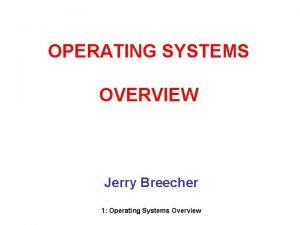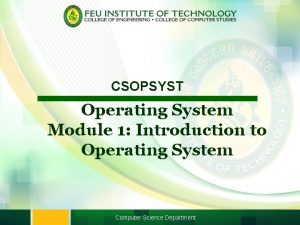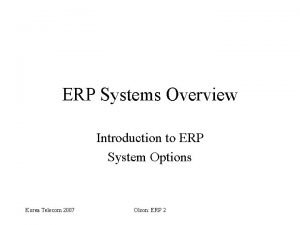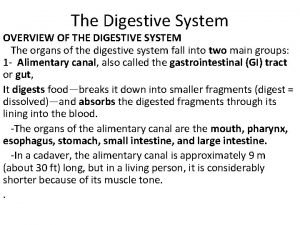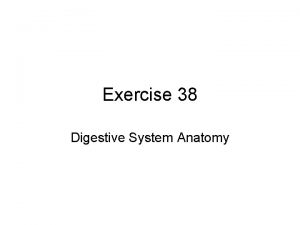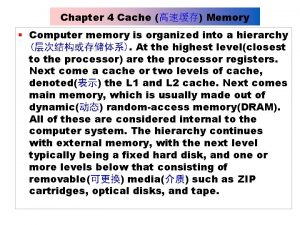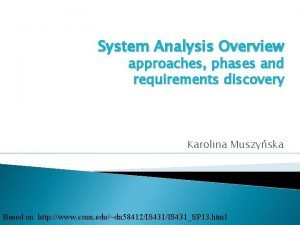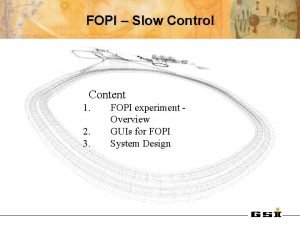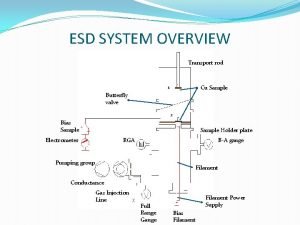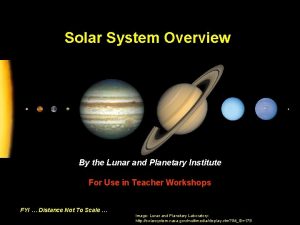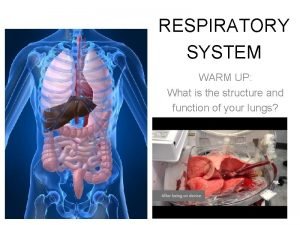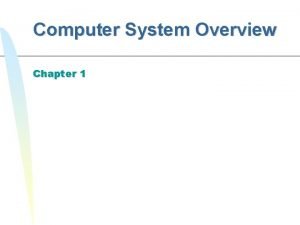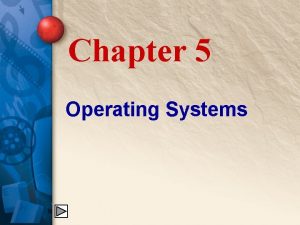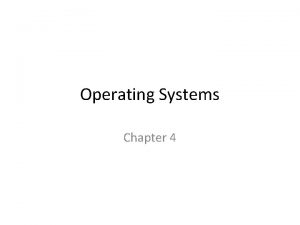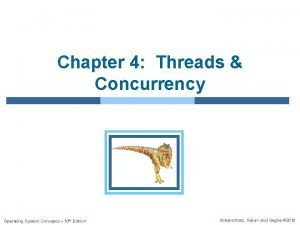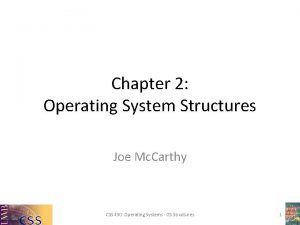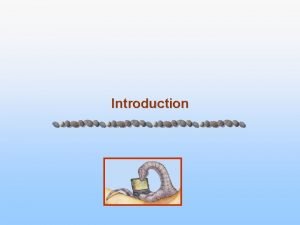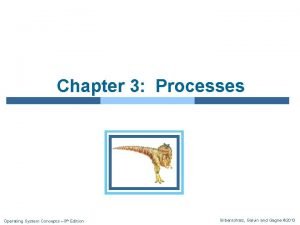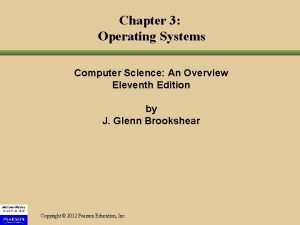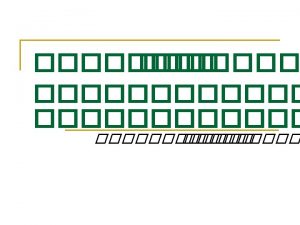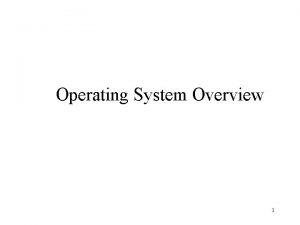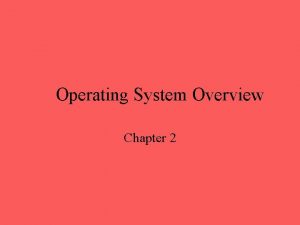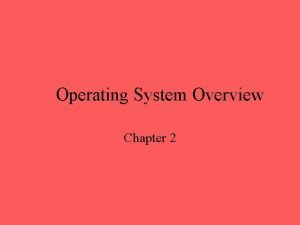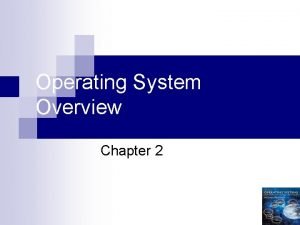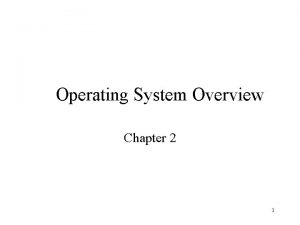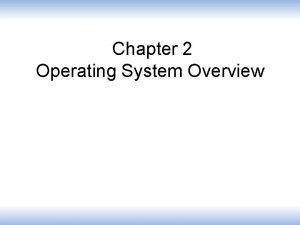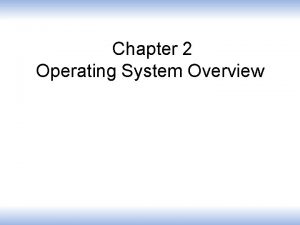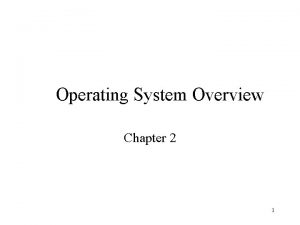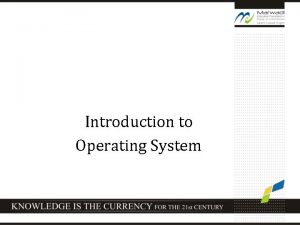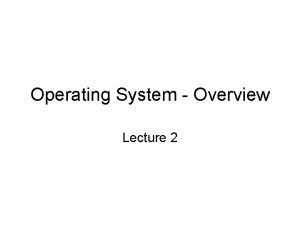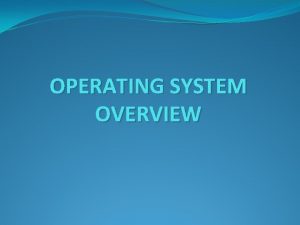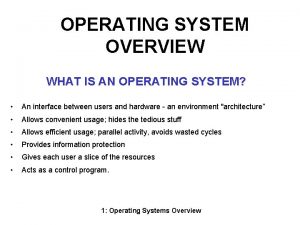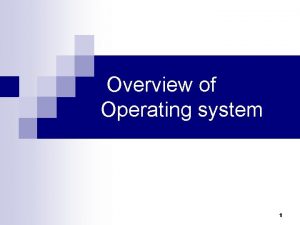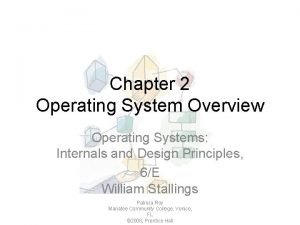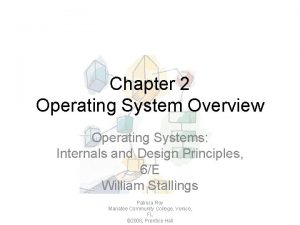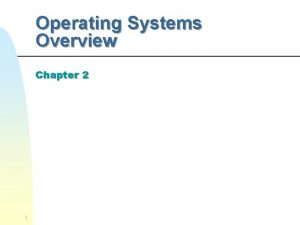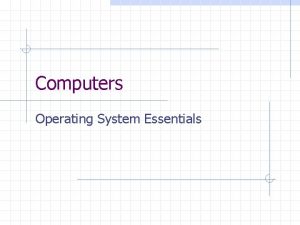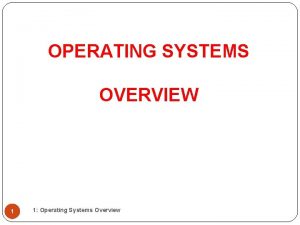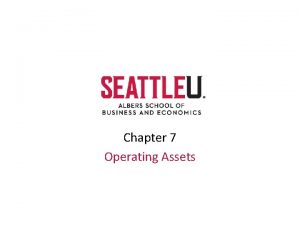Operating System Overview Chapter 2 Operating System A





















































- Slides: 53

Operating System Overview Chapter 2

Operating System • A program that controls the execution of application programs • An interface between applications and hardware

Operating System Objectives • Convenience – Makes the computer more convenient to use • Efficiency – Allows computer system resources to be used in an efficient manner • Ability to evolve – Permit effective development, testing, and introduction of new system functions without interfering with service

OS as a User/Computer Interface

Services Provided by the Operating System • Program development – Editors and debuggers • • Program execution Access to I/O devices Controlled access to files System access

Services Provided by the Operating System • Error detection and response – internal and external hardware errors • memory error • device failure – software errors • arithmetic overflow • access forbidden memory locations – operating system cannot grant request of application

Services Provided by the Operating System • Accounting – collect statistics – monitor performance – used to anticipate future enhancements – used for billing users

Operating System as a Resource Manager • Can we say that it is the OS that controls the movement, storage and processing of data? • Functions same way as ordinary computer software – It is program that is executed • Operating system relinquishes control of the processor to execute other programs


Kernel • Portion of operating system that is in main memory • Contains most-frequently used functions • Also called the nucleus

Ease of Evolution of an Operating System • Hardware upgrades and new types of hardware • New services • Fixes

Evolution of Operating Systems • Serial Processing – No operating system – Machines run from a console with display lights and toggle switches, input device, and printer – Schedule tome – Setup included loading the compiler, source program, saving compiled program, and loading and linking

Evolution of Operating Systems • Simple Batch Systems – Monitors • Software that controls the running programs • Batch jobs together • Program branches back to monitor when finished • Resident monitor is in main memory and available for execution

Desirable Hardware Features • Memory protection – do not allow the memory area containing the monitor to be altered • Timer – prevents a job from monopolizing the system • Privileged instructions – Executed only by the monitor • Interrupts

Uniprogramming • Processor must wait for I/O instruction to complete before preceding

Multiprogramming • When one job needs to wait for I/O, the processor can switch to the other job

Multiprogramming

Example JOB 1 JOB 2 JOB 3 Type of job Heavy compute Heavy I/O Duration 5 min. 10 min. Memory required 50 MB 100 MB 80 MB Need disk? No No Yes Need terminal No Yes No Need printer? No No Yes


Effects of Multiprogramming Uniprogramming Multiprogramming Processor use 20% 40% Memory use 33% 67% Disk use 33% 67% Printer use 33% 67% Elapsed time 30 min. 15 min. Throughput rate 6 jobs/hr 12 jobs/hr

Time Sharing • Using multiprogramming to handle multiple interactive jobs • Processor’s time is shared among multiple users – OS interleaves execution of each process in a short burst or quantum of computation. • Multiple users simultaneously access the system through terminals

Batch Multiprogramming versus Time Sharing


Major Achievements • • • Processes Memory Management Information protection and security Scheduling and resource management System structure

Processes • A program in execution • An instance of a program running on a computer • The entity that can be assigned to and executed on a processor • A unit of activity characterized by a single sequential thread of execution, a current state, and an associated set of system resources

Difficulties with Designing System Software • Improper synchronization – ensure a process waiting for an I/O device receives the signal • Failed mutual exclusion • Nondeterminate program operation – program should only depend on input to it, not relying on common memory areas • Deadlocks

Process • Consists of three components – An executable program – Associated data needed by the program – Execution context of the program • All information the operating system needs to manage the process

Process

Memory Management • • • Process isolation Automatic allocation and management Support for modular programming Protection and access control Long-term storage

Virtual Memory • Allows programmers to address memory from a logical point of view • The system provides for a dynamic mapping between virtual addresses and a real address. • Eliminates the requirement that all pages of a process reside in main memory simultaneously.

Scheduling and Resource Management • Fairness – give equal and fair access to all processes • Differential responsiveness – discriminate between different classes of jobs • Efficiency – maximize throughput, minimize response time, and accommodate as many users as possible

Major Elements of Operating System

System Structure • More features added to operating systems. • Underlying hardware has become more capable and versatile. • Number of lines of code in: – Windows 2000: 29 million – Windows XP: 40 million – Linux kernel 2. 6: 6 million – Debian 3. 1: 215 million

System Structure • Four problems: – Operating systems are chronically late in being delivered. – Systems have latent bugs that show up in the field and must be fixed and reworked. – Performance is often not what was expected. – It has proved impossible to deploy a complex operating system that is not vulnerable to a variety of security attacks, including virus, worms and unauthorized access.

System Structure • View the system as a series of levels • Each level performs a related subset of functions • Each level relies on the next lower level to perform more primitive functions • This decomposes a problem into a number of more manageable subproblems

Operating System Design Hierarchy Level Name Objects Example Operations 4 Interrupts Interrupt-handling programs Invoke, mask, unmask, retry 3 Procedures, call stack, display Mark stack, call, return 2 Instruction Set Evaluation stack, micro- Load, store, add, subtract program interpreter, branch scalar and array data 1 Electronic circuits Registers, gates, buses, Clear, transfer, activate, complement

Operating System Design Hierarchy Level Name Objects Example Operations 7 Segments, pages Read, write, fetch Virtual Memory 6 Local secondary store channels 5 Blocks of data, device Read, write, allocate, free Primitive processes Primitive process, semaphores, ready list Suspend, resume, wait, signal

Operating System Design Hierarchy Level Name Objects Example Operations 13 Shell environment User programming Statements in shell language 12 User processes Quit, kill, suspend, resume 11 Directories search, list Create, destroy, attach, detach, 10 Devices as printer, displays and keyboards External devices, such Open, close, read, write 9 File system Files read, write Create, destroy, open, close 8 Communications Pipes read, write Create, destroy, open. close,

Characteristics of Modern Operating Systems • Microkernel architecture – assigns only a few essential functions to the kernel • address space • interprocess communication (IPC) • basic scheduling

Characteristics of Modern Operating Systems • Multithreading – process is divided into threads that can run simultaneously • Thread – dispatchable unit of work – executes sequentially and is interruptable • Process is a collection of one or more threads

Characteristics of Modern Operating Systems • Symmetric multiprocessing – there are multiple processors – these processors share same main memory and I/O facilities – All processors can perform the same functions

Characteristics of Modern Operating Systems • Distributed operating systems – provides the illusion of a single main memory and single secondary memory space – used for distributed file system

Characteristics of Modern Operating Systems • Object-oriented design – used for adding modular extensions to a small kernel – enables programmers to customize an operating system without disrupting system integrity

Windows 2000 • Exploits the power of today’s 32 -bit microprocessors • Provides full multitasking in a singleuser environment • Client/Server computing

Windows 2000 Architecture • Modular structure for flexibility • Executes on a variety of hardware platforms (Intel x 86, Itanium).

OS Organization • Modified microkernel architecture – Not a pure microkernel – Many system functions outside of the microkernel run in kernel mode • Any module can be removed, upgraded, or replaced without rewriting the entire system

Layered Structure • Hardware abstraction layer (HAL) – Isolates the operating system from platformspecific hardware differences • Microkernel – Most-used and most fundamental components of the operating system • Device drivers – Translate user I/O function calls into specific hardware device I/O requests

W 2 K Executive • • I/O manager Cache manager Object manager Security reference monitor Process/thread manager Local procedure call (LPC) Facility Virtual memory manager Windows/graphics modules

Client/Server Model • Simplifies the Executive – possible to construct a variety of APIs • Improves reliability – each service runs as a separate process with its own partition of memory – clients cannot directly access hardware • Provides a uniform means for applications to communicate via LPC • Provides base for distributed computing


UNIX • Hardware is surrounded by the operating -system • Operating system is called the kernel • Comes with a number of user services and interfaces – shell – C compiler

UNIX

Modern UNIX Systems • • System V Release 4 (SVR 4) Solaris 2. x 4. 4 BSD Linux
 Operating system overview
Operating system overview Dual mode in os
Dual mode in os Financial intermediaries
Financial intermediaries A 23 year old male experienced severe head trauma
A 23 year old male experienced severe head trauma Emt chapter 14 medical overview
Emt chapter 14 medical overview Chapter 9 lesson 2 photosynthesis an overview
Chapter 9 lesson 2 photosynthesis an overview Chapter 12 selling overview
Chapter 12 selling overview Chapter 1 overview of verb tenses
Chapter 1 overview of verb tenses Overview of personal finance chapter 1
Overview of personal finance chapter 1 Overview of the dentitions chapter 11
Overview of the dentitions chapter 11 Introduction to personal finance chapter 1 answers
Introduction to personal finance chapter 1 answers General features of animals
General features of animals Chapter 1 an overview of financial management
Chapter 1 an overview of financial management Chapter 17 overview elements and their properties
Chapter 17 overview elements and their properties Chapter 1 overview of financial statement analysis
Chapter 1 overview of financial statement analysis Erp system overview
Erp system overview Content management system capabilities
Content management system capabilities What is computerized accounting information system
What is computerized accounting information system Ductus parotideus
Ductus parotideus Operative indicators in sap ps
Operative indicators in sap ps Use case diagram gym management system
Use case diagram gym management system Small intestine histology
Small intestine histology Set associative mapping in cache memory
Set associative mapping in cache memory Computer memory system overview
Computer memory system overview British school system presentation
British school system presentation British school system overview
British school system overview System design
System design System design overview
System design overview System overview sample
System overview sample Lpi
Lpi Cardiac notch
Cardiac notch Computer system overview
Computer system overview 5 operating systems
5 operating systems Types of operating system
Types of operating system Chapter 4 operating system
Chapter 4 operating system Operating system concepts chapter 8 solutions
Operating system concepts chapter 8 solutions Operating system concepts chapter 5 solutions
Operating system concepts chapter 5 solutions Operating system concepts chapter 5 solutions
Operating system concepts chapter 5 solutions Concurrency vs parallelism in os
Concurrency vs parallelism in os Operating system chapter 2
Operating system chapter 2 Operating system chapter 1
Operating system chapter 1 Operating system chapter 3
Operating system chapter 3 Operating system chapter 3
Operating system chapter 3 Buddy system memory
Buddy system memory File system in operating system
File system in operating system Ufs4.0
Ufs4.0 File system in operating system
File system in operating system Www overview
Www overview Maximo work order priority
Maximo work order priority Uml overview
Uml overview Uml overview
Uml overview Retail vertical
Retail vertical Figure 12-1 provides an overview of the lymphatic vessels
Figure 12-1 provides an overview of the lymphatic vessels Cardiopulmonary circulation
Cardiopulmonary circulation
